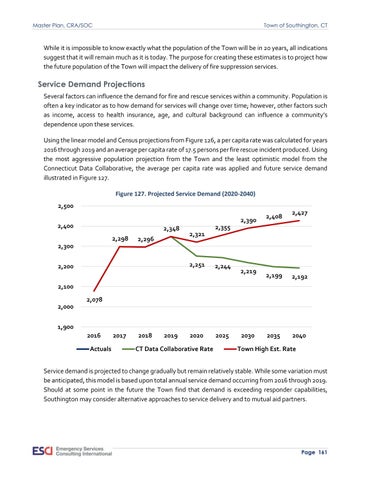Master Plan, CRA/SOC
Town of Southington, CT
While it is impossible to know exactly what the population of the Town will be in 20 years, all indications suggest that it will remain much as it is today. The purpose for creating these estimates is to project how the future population of the Town will impact the delivery of fire suppression services.
Service Demand Projections Several factors can influence the demand for fire and rescue services within a community. Population is often a key indicator as to how demand for services will change over time; however, other factors such as income, access to health insurance, age, and cultural background can influence a community’s dependence upon these services. Using the linear model and Census projections from Figure 126, a per capita rate was calculated for years 2016 through 2019 and an average per capita rate of 17.5 persons per fire rescue incident produced. Using the most aggressive population projection from the Town and the least optimistic model from the Connecticut Data Collaborative, the average per capita rate was applied and future service demand illustrated in Figure 127. Figure 127. Projected Service Demand (2020-2040) 2,500 2,390
2,400
2,348 2,298
2,296
2,408
2,427
2,355 2,321
2,300 2,251
2,200
2,244
2,219
2,199
2,192
2035
2040
2,100
2,078 2,000 1,900 2016 Actuals
2017
2018
2019
2020
CT Data Collaborative Rate
2025
2030
Town High Est. Rate
Service demand is projected to change gradually but remain relatively stable. While some variation must be anticipated, this model is based upon total annual service demand occurring from 2016 through 2019. Should at some point in the future the Town find that demand is exceeding responder capabilities, Southington may consider alternative approaches to service delivery and to mutual aid partners.
Page 161












